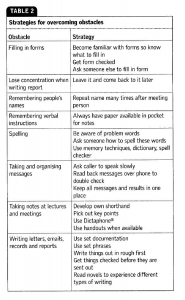‘‘Nurses with dyslexia [. . .] can use a multidimensional approach to patient care and can visualise a patient as an integrated whole. They can connect with a patient in way that integrates the art and science of nursing…(Dyslexic nurses) use ‘‘novel and creative problem solving measures that show an exceptional understanding of patients’ individual needs and the wider nursing issues involved in nursing care.’’
– Jacqueline Wiles, Nursing Standard
In the United Kingdom, the Royal College of Nursing has produced a toolkit of how to support students and employees with dyslexia, dyspraxia, and dyscalculia in the nursing profession although nothing similar is available here in the US.
The nursing profession can be well-suited to many dyslexic strengths that include (but are not limited to) people skills like social awareness and empathy, holistic and interconnected thinking, and dynamic reasoning. At the same time, specific career challenges are likely to occur and many student as well as practicing nurses are likely to have few resources or sources of support to turn to in the workplace.
Recently, a nurse shared her path to becoming a practicing nurse. She first became a certified nursing assistant and later entered a Bachelor of Science Nursing program:
“Becoming a CNA significantly contributed to my understanding of many principles I had learned in lecture on the fundamentals of patient care. As a CNA, I was able to learn at the bedside while developing relationships with patients and practicing the skills from both lab and clinicals. Nineteen days after finishing CNA training, I was employed at the location where we completed our clinicals. Having a job as a CNA provided me with the opportunity to make real the theory I had learned in class. The opportunity to work next to real nurses let me watch the lessons you cannot learn through books. My confidence grew as my dedication to complete the BSN degree cemented. Once I returned to the classroom as a student nurse, I was wholly committed to completing the program.”
 In the summer between her junior and senior years, she completed an externship on a telemetry floor of a major medical center: ” I enjoyed participating in an externship…This externship provided many opportunities for verbal questions and answers—my preferred learning style. My preceptor was incredible. She was open to learn about my learning needs, and we discussed possible precautions to take in order to maximize my performance on the floor.
In the summer between her junior and senior years, she completed an externship on a telemetry floor of a major medical center: ” I enjoyed participating in an externship…This externship provided many opportunities for verbal questions and answers—my preferred learning style. My preceptor was incredible. She was open to learn about my learning needs, and we discussed possible precautions to take in order to maximize my performance on the floor.
According to my preceptor, there was no evidence of disability in my performance. I did use a color transparency when there was a lot of material to read and comprehend, but that was the only accommodation I used on the floor. The transparency was also a folder that held materials that I needed, so it blended in discreetly.”
In one research article of nursing students with LDs, the group found that all “kinaesthetic/tactile learners, that is those who learn best when they are involved or active participants. However, she found that there were differences in learning strategies between them. Some students found that written directions, skills labs and clinical practice provided strategies for learning nursing concepts and remembering details. Others noted that oral directions, reviewing tasks orally prior to performing them in clinical practice, and reading aloud assisted their learning.”
Other helpful strategies mentioned by nurses or nursing students:
– colored pens and colored stickers to assign tasks
– pre-reading prior to placement
– arriving early for shift to make note of names and diagnoses
– short hand abbreviations
– Dictaphone – recording reminders, case work
– Software for spellchecking, reading, dictionary, definitions, mindmapping
– colored overlays, color adjustments on computer displays
– headphones
– voice recognition software
– calculator or software to help with drug calculations
– notebook or diary
Check out other resources recommended by the Royal College of Nursing
















